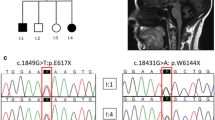Abstract
The spinocerebellar ataxias (SCAs) with autosomal dominant inheritance are a clinically and genetically heterogeneous group of neurodegenerative disorders. To date 27 different loci have been identified for these conditions. Recently, two deletions as well as one missense mutation in the beta-III spectrin gene (STBN2) were identified causing SCA5. To evaluate the clinical relevance of these mutations, we screened 310 familial and sporadic patients with ataxia. While none of the individuals tested had evidence for one of the known SCA5 mutations, additional sequencing of the coding region for 22 unrelated patients revealed three novel missense exchanges at evolutionary conserved amino acid positions. Even though each variation marks a unique genotype in 250 alleles, a disease causing capacity can be excluded with high probability. These results reflect the challenges for molecular analyses in SCA5.
Similar content being viewed by others
References
Manto MU (2005) The wide spectrum of spinocerebellar ataxias (SCAs). Cerebellum 4:2–6
Ikeda Y, Dick KA, Weatherspoon MR, Gincel D, Armbrust KR, Dalton JC, Stevanin G, Dürr A, Zühlke Ch, Bürk K, Clark HB, Brice A, Rothstein JD, Schut LJ, Day JW, Ranum LPW (2006) Spectrin mutations cause spinocerebellar ataxia type 5. Nat Genet 38:Z84–Z190
Waters MF, Minassian NA, Stevanin G, Figueroa KP, Bannister JP, Nolte D, Mock AF, Evidente VG, Fee DB, Müller U, Dürr A, Brice A, Papazian DM, Pulst SM (2006) Mutations in voltage-gated potassium channel KCNC3 cause degenerative and developmental central nervous system phenotypes. Nat Genet 38:447–451
van de Warrenburg BP, Verbeek DS, Piersma SJ, Hennekam FA, Pearson PL, Knoers NV, Kremer HP, Sinke RJ (2003) Identification of a novel SCA14 mutation in a Dutch autosomal dominant cerebellar ataxia family. Neurology 61:1760–1765
Yabe I, Sasaki H, Chen DH, Raskind WH, Bird TD,Yamashita I, Tsuji S, Kikuchi S, Tashiro K (2003) Spinocerebellar ataxia type 14 caused by a mutation in protein kinase C gamma. Arch Neurol 60:1749–1751
Chen DH, Cimino PJ, Ranum LP, Zoghbi HY, Yabe I, Schut L, Margolis RL, Lipe HP, Feleke A, Matsushita M, Wolff J, Morgan C, Lau D, Fernandez M, Sasaki H, Raskind WH, Bird TD (2005) The clinical and genetic spectrum of spinocerebellar ataxia 14. Neurology 64:1258–1260
Klebe S, Dürr A, Rentschler A, Hahn-Barma V, Abele M, Bouslam N, Schöls L, Jedynak P, Forlani S, Denis E, Dussert C, Agid Y, Bauer P, Globas C, Wüllner U, Brice A, Riess O, Stevanin G (2005) New mutations in protein kinase C gamma associated with spinocerebellar ataxia type 14. Ann Neurol 58:720–729
Dalski A, Atici J, Kreuz F, Hellenbroich Y, Schwinger E, Zühlke Ch (2005) Mutation analysis in the Fibroblast Growth Factor 14 gene: Frameshift mutation and polymorphisms in patients with inherited ataxias. Eur J Hum Genet 13:118–120
van Swieten JC, Brusse E, de Graaf BM, Krieger E, van de Graaf R, de Koning I, Maat-Kievit A, Leegwater P, Dooijes D, Oostra BA, Heutink P (2003) A mutation in the fibroblast growth factor 14 gene is associated with autosomal dominant cerebellar ataxia. Am J Hum Genet 72:191–199
Dalski A, Mitulla B, Bürk K, Schattenfroh Ch, Schwinger E, Zühlke Ch (2006) Mutation of the highly conserved residue 131 of the SCA14 associated PRKCG gene in a family with slow progressive cerebellar ataxia. J Neurol 253:1111–1112
Ranum LP, Schut LJ, Lundgren JK, Orr HT, Livingston DM (1994) Spinocerebellar ataxia type 5 in a family descended from the grandparents of President Lincoln maps to chromosome 11. Nat Genet 8:280–284
Bürk K, Zühlke C, König IR, Ziegler A, Schwinger E, Globas C, Dichgans J, Hellenbroich Y (2004) Spinocerebellar ataxia type 5 (SCA5): clinical and molecular genetic features of a large German kindred. Neurology 62:327–329
Stevanin G, Herman A, Brice A, Dürr A (1999) Clinical and MRI findings in spinocerebellar ataxia type 5. Neurology 53:1355–1357
Author information
Authors and Affiliations
Corresponding author
Rights and permissions
About this article
Cite this article
Zühlke, C., Bernard, V., Dalski, A. et al. Screening of the SPTBN2 (SCA5) gene in German SCA patients. J Neurol 254, 1649–1652 (2007). https://doi.org/10.1007/s00415-007-0600-1
Received:
Revised:
Accepted:
Published:
Issue Date:
DOI: https://doi.org/10.1007/s00415-007-0600-1




